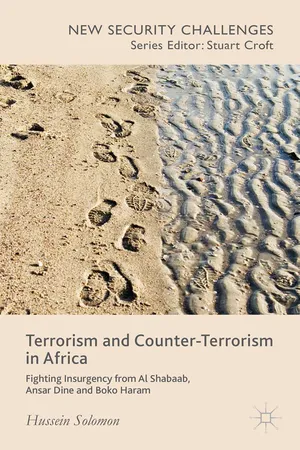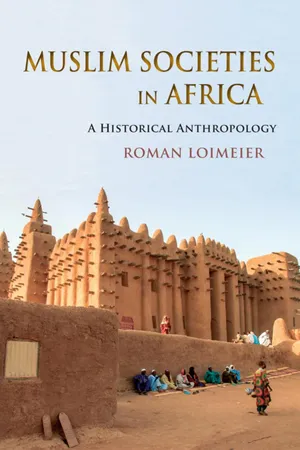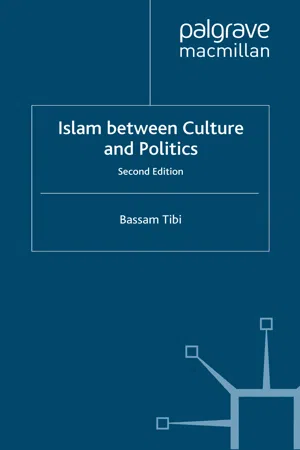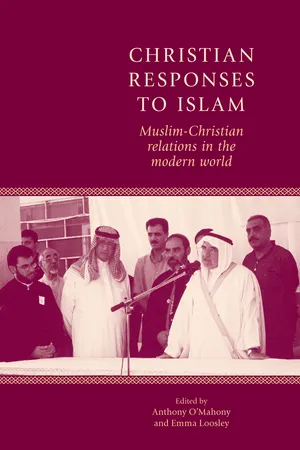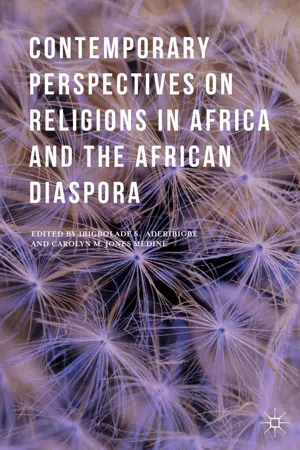History
Islam in Africa
Islam in Africa has a rich history dating back to the 7th century, when it was introduced through trade and conquest. Over time, it became deeply rooted in various regions, influencing culture, politics, and society. The spread of Islam in Africa led to the formation of powerful empires, such as the Mali and Songhai, and contributed to the development of vibrant intellectual and artistic traditions.
Written by Perlego with AI-assistance
Related key terms
1 of 5
9 Key excerpts on "Islam in Africa"
- Brendan Carmody(Author)
- 2018(Publication Date)
- Gadsden Publishers(Publisher)
The type of Islam brought by Islamic conquest and Muslim traders was complemented by Sufi Islam. The communal organization and most of the practices of the Sufi Brotherhoods struck a common chord with African traditional religious. The toleration of indigenous practices enabled the new converts to embrace Islam without being forced to abandon most of their former traditional practices. Later reform movements, however, saw it as their duty to rid Islam of practices they deemed unorthodox. For a long period, the early Muslim communities founded on the African continent remained localized mostly in North and West Africa, as well as the Horn of Africa and along the eastern coast. Improved communication during the colonial era linked with job opportunities created by the colonial civil service facilitated internal movements within the continent and thus, indirectly, contributed to the spread of Islam inland. Muslims also migrated to Africa mostly from Asia in this period, as was the case for the Ismailis of Indian origin in East Africa and Muslims of Indonesian origin in South Africa. African Conversion: Entering the Fold of Islam 219 World of Traditional African Religion To understand religious conversion, a brief presentation of the African world of religions is in order. Having already noted some elements of Islam, it is also important to present the general religious background of those who converted to Islam. Where did they come from? How did they choose to become Muslims? What motivated them? How can we account for their change of religious affiliation? Today, understanding African conversion to Islam, as noted earlier, has to be considered on two levels, namely, that of conversion within the context of African traditional religions and conversion within the context of modernity. When speaking of the African worldview, it needs to be remembered that there are different African worldviews, given the vastness of the continent and its variety of cultures.- eBook - ePub
Terrorism and Counter-Terrorism in Africa
Fighting Insurgency from Al Shabaab, Ansar Dine and Boko Haram
- H. Solomon(Author)
- 2015(Publication Date)
- Palgrave Macmillan(Publisher)
2 Islam in Africa IntroductionThose who have researched and/or travelled to Africa are struck by the distinctive, moderate and tolerant Islam practised on the continent. Indeed Eva Rosander1 has referred to this phenomenon as ‘African Islam’. By this she means an Islam that takes local context into consideration and is accommodating and flexible – not one that is dogmatically rigid. This African Islam is intimately tied to the mystical and spiritual aspects of Islam known as Sufism, or, in Arabic, tasawwuf .2 Unlike the formal ritualistic aspects of those subscribing to a more scripturalist Islam, which stress the chasm between man and god,3 Sufi brotherhoods or paths (tariqa in Arabic) stress the need to bridge that gap through love and knowledge of the true inner self. Many African Muslims were Sufi in orientation. This form of the Islamic faith is more personal and more emotional, stressing the love of god as opposed to the fear of god. Moreover Sufi Islam coexisted4 with the richness of pre-Islamic folk customs.5The accommodating and tolerant aspects of Sufi Islam are seen in its dominant traits being ‘ecstatic dancing (hadra ), spirit possession and expulsion and visits to “saints” and tombs’.6 These traits, in turn, are in keeping with much African traditional religious practices and accounts for Sufi Islam’s popularity across the length and breadth of Africa. Under the circumstances, this Sufi Islam continues to attract the largest number of adherents to Islam in Africa.7In recent years, Sufi Islam has come under increasing threat from Islamism. What is Islamism and how is it that it has increasingly displaced traditional Sufi practices across the length and breadth of Africa?Understanding the Islamist ideologyIslamism is a twentieth-century totalitarian ideology that seeks to mould Islamic religious tradition to serve narrow political ends of domination.8 Indeed, Islamism is sometimes interchangeably used with Political Islam. According to Zeynep and Ahmet Kuru:9 - eBook - PDF
Muslim Societies in Africa
A Historical Anthropology
- Roman Loimeier(Author)
- 2013(Publication Date)
- Indiana University Press(Publisher)
The differences between Muslim societies in Africa (and beyond) may be explained by diverging geographical settings, different historical experiences, and modes of interaction with other religious cultures and traditions. At the same time, the greater tradition of Islam has been accepted and interpreted selectively in different societies, contexts, and times. Local contexts have remained important defining frameworks and spaces of reference for the realization of the greater tradition of Islam. Equally, established and seemingly obsolete social and religious practices may show astonishing persistence, despite the onslaught of gen-erations of reformers. Muslims have shown remarkable resilience, for instance, with respect to the reformist critique of the celebration of the mawlid, the birthday of the Prophet, which has remained a popular festival despite centuries of scholarly critique. The multiple character of Muslim societies and the persistence of local traditions of learning may thus be explained, at least to some extent, by the very vitality of local traditions of learning. The interaction between the local context and the greater tradi-tion of Islam must not necessarily lead to greater uniformity in expression and inter-pretation, precisely due to the fact that the reference to the canon usually comes from the local context and is linked with its particularities. The interaction between the local and the canon can even stimulate the further accentuation of the local and lead to a further expansion of the interpretative framework of the canon. After all, even Is There an “African” Islam? | 27 the most trans-local religious scholar is still rooted in a local context and the success of each movement of reform is equally linked with its capability to translate a pro-gram of reform into multiple local settings and their respective realities. Despite the undisputed importance of the “unifying forces” of Islam, differences in interpretation thus persist. - eBook - PDF
- B. Soares, R. Otayek(Authors)
- 2007(Publication Date)
- Palgrave Macmillan(Publisher)
We need to understand how African Muslims and others are involved in, affected by, and making sense of these momentous changes of the past ten or fifteen years, and how the practice of Islam and Muslim politics in Africa have been changing. In the chapters that follow, the contributors suggest ways of coming to such understand- ings. In our view, it is through dynamics internal to African societies, such as the crisis of the state, the failures of economic development, the deterioration of educational and health care systems, massive urbanization, and demographic expansion, that the recourse to religion, and to Islam in particular, must be largely understood. In the remainder of this Introduction, we focus on three sets of interrelated issues that help us to understand Islam and Muslim politics in contemporary sub-Saharan introduction / 7 Africa: first, Islam and transnationalism; second, changes associated with political liberalization and the expansion of the public sphere; and, finally, political Islam or Islamism and recent possible alternatives. Islam and Transnationalism Many have emphasized the increased transnational exchanges and global intercon- nections between Africa and the rest of the world. However, little sustained attention has been paid to the actual implications of transnational Islam in sub-Saharan Africa. 11 The globalization of Islam has, of course, a long history. The umma, the global community of Muslims, is, after all, supranational by definition. But in recent years the speed and intensity of the interconnections between Muslims in Africa and the rest of the world have increased rapidly. Despite current preoccupations with the “deterritorialization” of radical Islamism, the articulation of the local and the global in Islam and Muslim societies and transnational Islam (Coulon 2002, Soares 2005, Loimeier and Seesemann 2006) cannot be reduced to the shadowy activities of Islamist networks. - eBook - PDF
Religious Plurality in Africa
Essays in Honour of John S. Mbiti
- Jacob K. Olupona, Sulayman S. Nyang, Jacob K. Olupona, Sulayman S. Nyang(Authors)
- 2013(Publication Date)
- De Gruyter(Publisher)
Islamic revivalism in West Africa: Historical perspectives and recent developments Sulayman S. Nyang Introduction Islam came to the African continent very early in its history. When Prophet Muhammad and his small band of followers were severely persecuted by the Meccans, he advised his followers to seek refuge in what was then known as Abyssinia (modern day Ethiopia). This event which is known in Muslim tradition as the first hijrah, played an important role in the Islamic movement. As Imam Buhari reported in his Sahih Buhari, the Muslim refugees returned to Arabia only after Muslim successes in the battle against the kafirun 'infidels' made it clear that it was safe to return to their homeland. Those who returned and joined the Holy Prophet Muhammad at Medina are now known in Islamic annals as the people of the ship. This is to say that they travelled by boat to return home. What we learn from this event is that Africa was the place of refuge for the Muslims and this event brought the Muslim movement to the African mainland and later on men like Amr ibn al-As would lead their armies across North Africa to conquer Egypt. But if the early Islamic movement established contact with Ethiopia and Egypt soon after the movement was founded or soon after the Holy Prophet passed away, the fact still remains that Islam did not reach the areas south of the Sahara until much later in the history of this global movement. Yet, in saying that Islam's arrival in sub-Saharan Africa dates back to post-medieval period, one is not suggesting that Islam in Africa has not shared or benefitted from the activities of Muslim revolution-aries and reformers. Indeed Africa's contribution to the Islamic move-ment lies precisely in the number of Muslim warriors who took up 232 Sulayman S. Nyang arms fi sabilillah. This African army for Allah's sake was instrumental in the establishment of Muslim regimes in the West Sudan. - eBook - PDF
- Bassam Tibi(Author)
- 2005(Publication Date)
- Palgrave Macmillan(Publisher)
This creates confusion and brings about a need to specify what, in fact, Islam is. Before I turn to introducing Islam equally in its unity and diversity it is important to underline the fact that the increasing significance of religion in our age is not restricted to Islam. Religion 38 in general and politicised religion, that is, religious fundamentalism, 39 in particular, are moving to centre-stage globally and this can be observed in all civilisations. What is Islam? Unity and diversity in historical perspective: religion between doctrine and reality My first and equally decisive encounter as an Arab Muslim born and brought up in Damascus with a non-Arab variety of Islam was in West Africa during my work in Senegal 40 in the summer of 1982. Subsequent work in many and diverse African and Asian Muslim societies re- inforced my attitudes. During a discussion with Senegalese writers and Arab diplomats in Dakar, a heated argument arose as to whether drum- ming could be recognised as an Islamic ritual and whether belief in magic was at all admissible in Islam. For the Senegalese neither of these questions is controversial because drumming and magic both form part of their everyday culture; Arab participants, however, rejected both these phenomena on the grounds that they were ‘un-Islamic’. 41 On another occasion, at an international philosophy conference in November 1979, an Indonesian scholar of religion, Mukti Ali, lectured on the Indonesian conception of Islam; his remarks provoked discord among professors of al-Azhar University (the oldest Islamic university) because for them there is only one monolithic Islam, based on their own Arabocentric preconception. 42 In the spring of 2000, in an open discussion in Cairo I was victim of the very same al-Azhar doctrine Islam as a Cultural System 37 - eBook - PDF
Christian responses to Islam
Muslim-Christian relations in the modern world
- Anthony O'Mahony, Emma Loosley(Authors)
- 2024(Publication Date)
- Manchester University Press(Publisher)
The inƪuence of the latter may be signiƤcantly reduced but cannot be completely superseded. Its strength in persistence will often be shown at times of aƫiction. 14 Islam, spreading in West Africa from the ninth and tenth centuries, made provisions for a long transitory period of conversion. Muslims appeared on the southbound trade routes and gradually settled along them. Their skills and goods made them attractive at least to some strata of local societies and that led to their incorporation into the local social systems. Islamisation of African soci- eties was a slow, gradual but also reversible process with diơerent dynamics among various ethnic groups. Most of the merchants, and even the ‘ulama, were not driven by a missionary zeal and the long transitory conversion period for the local converts was simply a part of everyday life. 15 Muslims who temporarily or permanently settled in a place often married local women. Their presence inƪuenced the local population and also attracted other Muslims to come and stay. Local merchants accepted Islam also as a new signiƤcant feature of their profession if they wanted to become engaged in the long distance trade. In some centralised political entities, like the Songhay empire, Islam reached a promi- nent position in society but the rulers still held those of their subjects who adhered to traditional local religions in high esteem and often rulers themselves refrained from being Muslims, at least overtly. In other political units, like the Ashanti empire, Muslims were incorporated into the social system with hardly any prospects of social promotion. 16 Christianity was a late comer in the region, becoming a more signiƤcant element in the local context only from the mid-nineteenth century. It came from the coast and from the later part of that century its advances were often associ- ated with the European colonial conquest and presence. - eBook - PDF
Africans
The History of a Continent
- John Iliffe(Author)
- 2017(Publication Date)
- Cambridge University Press(Publisher)
Cultivators, whose circumstances 54 africans: the history of a continent were exactly the opposite, probably resisted Islam most strongly. Rulers, concerned to preserve political unity, generally patronised all their subjects’ religious activities in an eclectic manner. That was clearly the case in Mali and also in eleventh-century Gao, whose ruler had been the first in tropical Africa to accept Islam, sometime before ad 1000, followed by Takrur (before 1040) and Kanem (later in the century), while Ghana appears to have adopted orthodox Sunni Islam under Almoravid pressure during the 1070s. The eleventh century was a breakthrough period for Islam, as it was on the East African coast, although the extent of conversion varied greatly. In Ghana and Gao, Islam seems long to have been confined to traders and the court, but in Takrur and Kanem it spread more quickly to the common people and aroused conflict between Islamic teachers and the practitioners of magic (closely associated with ironworking) who had previously served the throne. trade and islam in east africa Whereas Islam reached West Africa across the world’s harshest desert, it travelled to East Africa along the easily navigated trade routes of the Indian Ocean. A mariner’s guide shows that during the first century after Christ traders from southern Arabia and the Red Sea penetrated down the East African coast to ‘Rhapta’, somewhere in modern Kenya or Tanzania, where the main export was ivory. Iranian pottery of the fifth to seventh centuries not only appears at sites on the coast from the Horn of Africa to Chibuene in southern Mozambique, but it has been found some sixty kilometres inland of Bagamoyo in Tanzania, suggesting that the Indian Ocean trade was already linked to a regional commerce comparable on a smaller scale to that of the middle Niger. This doubtless underlay the first appearance of Islam in East Africa at Shanga, a settlement in the Lamu Archipelago off the northern coast of Kenya. - Carolyn M. Jones Medine, Ibigbolade S. Aderibigbe, Carolyn M. Jones Medine, Ibigbolade S. Aderibigbe, Kenneth A. Loparo, Hans D Seibel(Authors)
- 2015(Publication Date)
- Palgrave Macmillan(Publisher)
Chapter 8 Islam in the Contemporary African Society R. Ibrahim Adebayo Introduction The word Ifriqiya has featured prominently in some Muslim history books, although it does not connote the contemporary continent of Africa. The name has been given various interpretations by different scholars. It is believed by Leo Africanus to have been derived from an Arabic word Faraqa, which means to divide—an indication of the division of Africa from Europe and Asia by the Mediterranean and the Nile respectively. 1 According to Al-Masudi, the name is also said to have been taken from Ifriqos bin Qais bin Saifi, one of the kings of Yemen. Some other historians hold that it came from the name of Ifriq, son of Quatura, the second wife of the patriarch. 2 Whatever the case may be, the con- tinent of Africa has remained one of the seven continents of the world and has been known to the Arabs and non-Arabs to include North Africa (including the Maghrib), East Africa, West Africa, Central Africa, and South Africa. 3 The initial contact of Islam with the African community is dated back to the time of Prophet Muhammad in the year 615 CE. The maltreatment and persecution of the early Muslims by the Makkans caused the Prophet to suggest to the Muslims to migrate to Abyssinia, which he described as a place “where a king rules without injustice and a land of truthfulness.” 4 The first batch of Muslim immigrants to Abyssinia, numbering 16—12 men and 4 women—was led by Uthman ibn Affan and his wife Ruqayah, the daughter of Prophet Muhammad. Soon afterward, the second batch consisting of 83 men and 11 women joined them. The warm reception accorded the Muslims in the land of Africa, and the denial of king Negus to hand over the Muslims to the Makkans who made a move for their expatriation back to Makkah, confirmed the foresightedness of the Prophet to have suggested the place.
Index pages curate the most relevant extracts from our library of academic textbooks. They’ve been created using an in-house natural language model (NLM), each adding context and meaning to key research topics.

